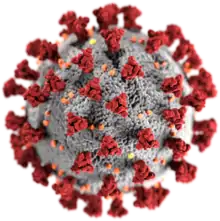Peplomer
Peplomer [Gr. peplos = robe, (woman’s) dress + Gr. meros = part] (also called a spike) is one of the knoblike structures (spikes), generally composed of glycoproteins (spike protein), projecting from the lipid bilayer of the surface envelope of an enveloped virus. Peplomers play important roles in the infection process; they are responsible for the attachment of the virion to receptor sites on the host cell surface, and they bring about the release of the nucleocapsid into the host cell cytoplasm by triggering fusion between the envelope and host membranes. They may have hemagglutinating activity or have enzyme activity such as neuraminidase. They are surface antigens.[1] [2][3][4]

.jpg.webp)
The term peplomer is rarely used today and is no longer used for all outwardly protruding envelope proteins; it is mostly replaced by the less precise expression spikes. However, this suggests a pointed structure, which is not the case with these envelope structures; they are round, flattened or button-shaped on the outside. Both terms, peplomer and spikes, however, only describe a morphologically visible structure and are not identical to the expression membrane protein or coat protein; many other membrane proteins in viruses do not form these prominent structures.
Peplomers can be seen in electron micrographs on the surface of enveloped viruses such as Orthomyxoviruses, Paramyxoviruses, Rhabdoviruses, Filoviruses, Coronaviruses, Bunyaviruses, Arenaviruses, and Retroviruses.[5]
The tail fibers of some bacteriophages, especially the T4-like phages, are modified peplomers.
Influenza virus has two kinds of peplomers:
- Cylinder shaped "haemagglutinin"
- Mushroom-shaped "neuraminidase".[6]
See also
References
- Brian Mahy. The Dictionary of Virology. 4th Edition 2009.
- Taber's Cyclopedic Medical Dictionary (21st ed.). F. A. Davis Company. 2009.
- Dorland's Illustrated Medical Dictionary (32nd Edition). Saunders 2011.
- Saunders Comprehensive Veterinary Dictionary (3rd ed.). Elsevier, Inc. 2007. as cited in "peplomer". The Free Dictionary. Farlex. 2011. Retrieved 30 March 2011.
- Christopher J. Burrell, Colin R. Howard, Frederick A. Murphy. Fenner and White’s Medical Virology. Fifth Edition. 2017
- "Types of Influenza Viruses". Centers for Disease Control and Prevention. 18 November 2019. Retrieved 22 November 2020.
Further reading
- F. Fenner et al.: The Biology of Animal Viruses, 2. Auflage, New York, London 1968, ISBN 0-12-253040-3, S. 5f
- D. J. Garwes et al.: Identification of epitopes of immunological importance on the peplomer of porcine transmissible gastroenteritis virus. Adv Exp Med Biol. (1987) 218: S. 509–515, PMID 2449047
- H. G. Niesters et al.: The peplomer protein sequence of the M41 strain of coronavirus IBV and its comparison with Beaudette strains. Virus Res. (1986) 5(2-3): S. 253–263, PMID 2429473
